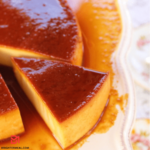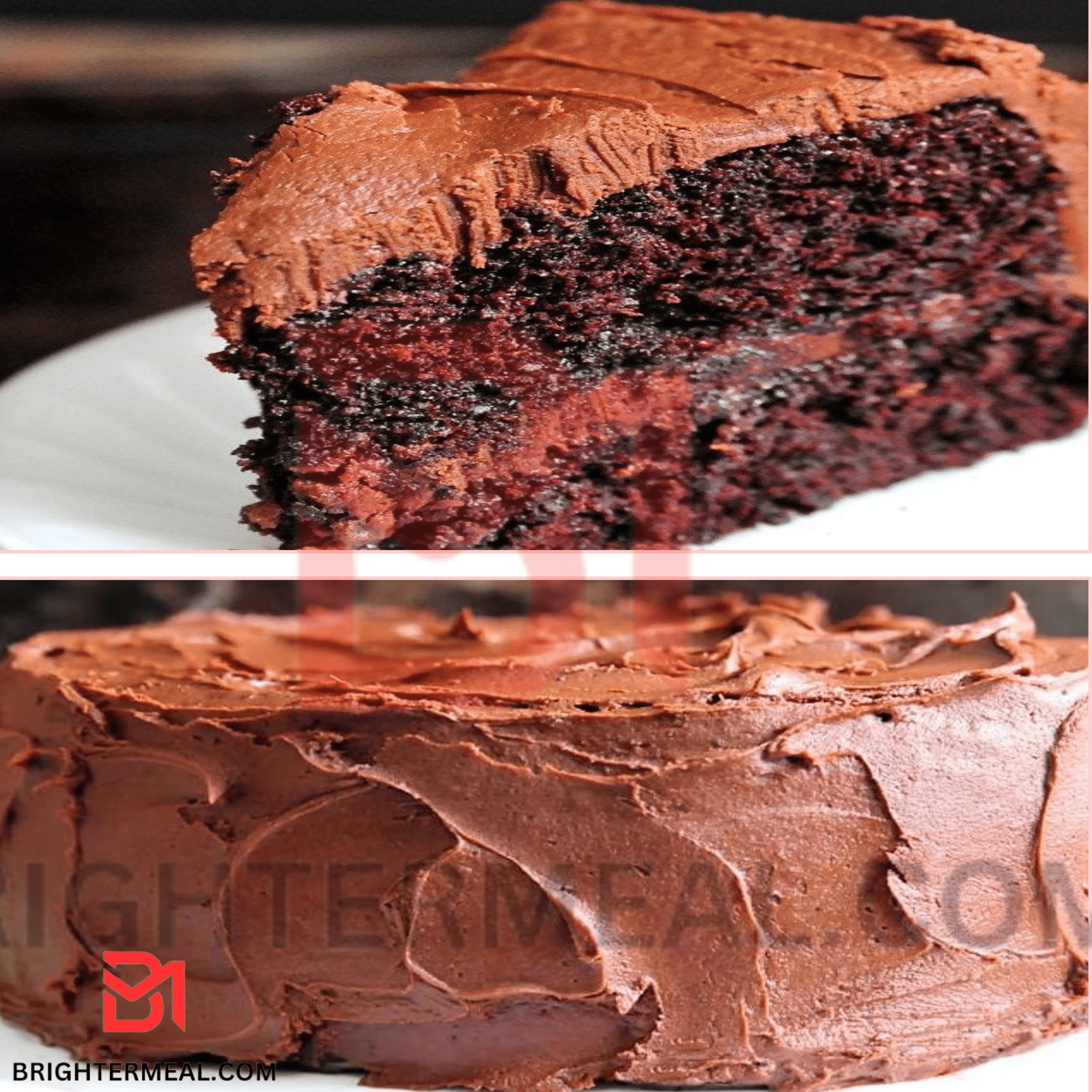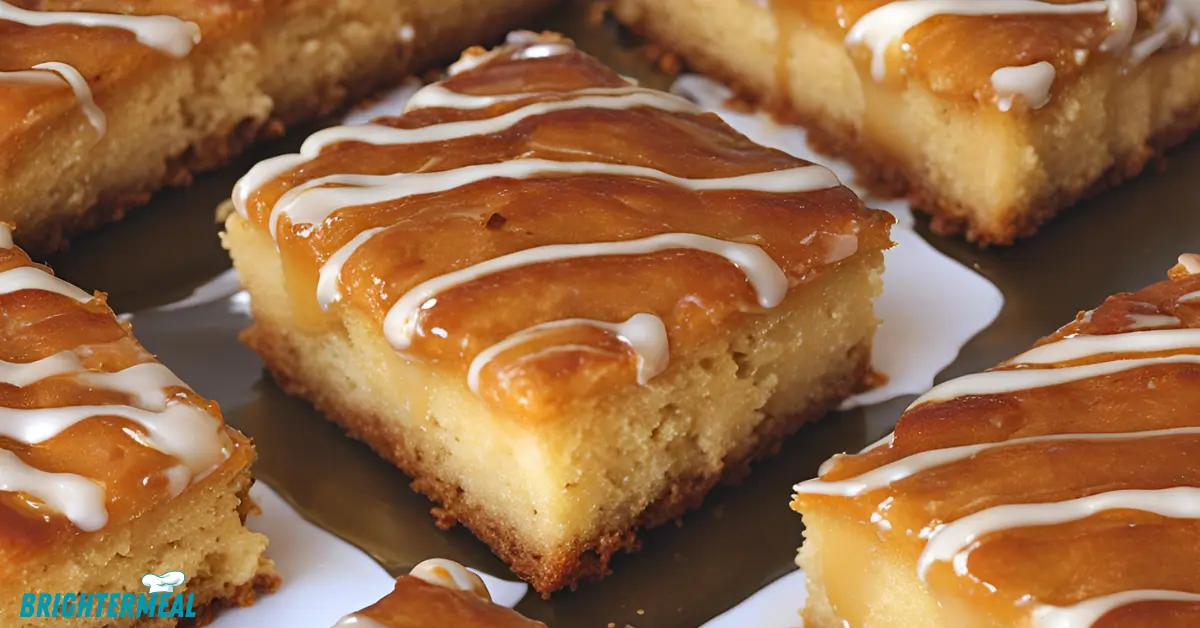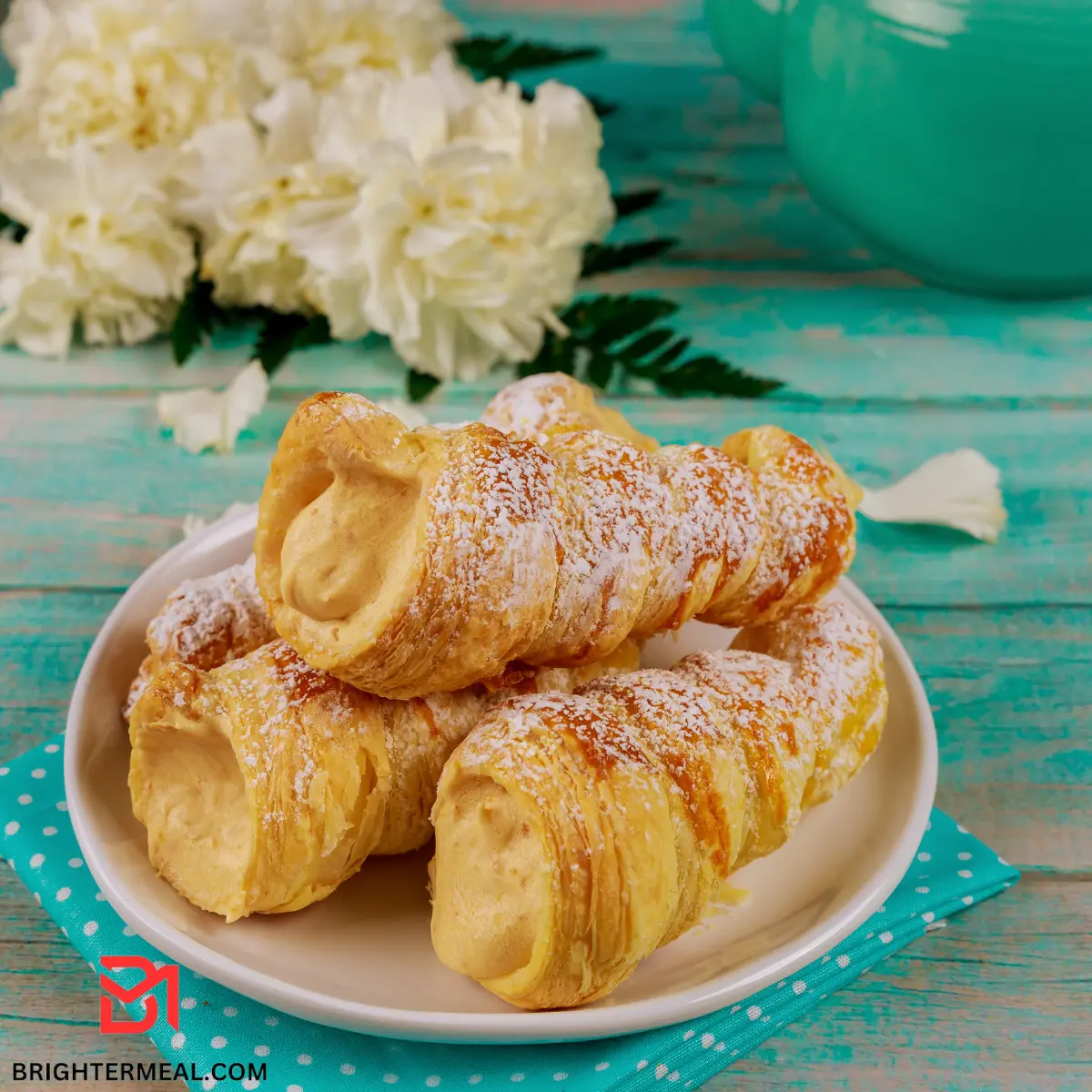Homemade Flan Cake
Homemade flan cake, a delightful dessert that combines the creamy texture of flan with the richness of cake, is a beloved treat in many households around the world. This delectable creation tantalizes taste buds with its smooth custard layer atop a moist cake base, often crowned with a luscious caramel glaze. Whether served as a decadent finale to a special meal or enjoyed as a sweet indulgence any time of day, homemade flan cake is sure to impress with its elegant presentation and irresistible flavor.

History and Origins
The Origins of Flan Cake
Flan cake, also known as “flancocho” or “impossible cake” in some regions, traces its roots to traditional flan recipes and cake baking techniques. The precise origin of flan cake is somewhat murky, but it is believed to have originated in Latin America, particularly in countries like Mexico, Puerto Rico, and the Dominican Republic. Early versions likely emerged as a creative fusion of European custard desserts and local culinary traditions.
Evolution of Flan Cake Recipe
Over time, the recipe for flan cake has evolved and diversified, with cooks around the world adding their own unique twists and adaptations. While the classic version typically features a vanilla sponge cake base and a creamy caramel-flavored flan layer, modern variations abound, incorporating flavors like chocolate, coconut, coffee, or even fruits like mango or passionfruit. This versatility has contributed to the enduring popularity of flan cake as a customizable dessert option for any occasion.
Ingredients Required
Essential Ingredients
The ingredients for homemade flan cake are relatively simple and readily available in most grocery stores. Common components include eggs, sugar, milk, flour, baking powder, vanilla extract, and a pinch of salt. The key to achieving the perfect texture and flavor lies in using high-quality ingredients and following the recipe’s proportions carefully.
Variations and Customizations
One of the joys of making homemade flan cake is the opportunity to experiment with different flavor combinations and presentations. For those looking to put a unique spin on this classic dessert, consider incorporating ingredients like cocoa powder, shredded coconut, almond extract, or citrus zest into the cake batter. Additionally, swapping out the traditional caramel glaze for alternative toppings such as dulce de leche, fruit compote, or whipped cream can add an extra layer of indulgence to the final product.
Step-by-Step Preparation Guide
Preparing the Caramel Sauce
The first step in making homemade flan cake is preparing the caramel sauce, which will form a decadent glaze on the finished dessert. To make the caramel, simply heat sugar in a saucepan over medium heat, stirring constantly until it melts and turns a rich amber color. Be careful not to let the sugar burn, as this can impart a bitter taste to the caramel. Once the desired color is achieved, pour the caramel into the bottom of a cake pan or mold, swirling to coat the bottom evenly.
Making the Flan Mixture
Next, prepare the flan mixture by combining eggs, sweetened condensed milk, evaporated milk, and vanilla extract in a blender or mixing bowl. Blend or whisk the ingredients together until smooth and well combined. Some recipes may call for additional flavorings or spices, such as cinnamon or nutmeg, to enhance the flan’s taste and aroma.
Assembling the Cake
With the caramel sauce and flan mixture prepared, it’s time to assemble the cake. Carefully pour the flan mixture over the caramel layer in the cake pan, taking care not to disturb the caramel coating. Then, prepare the cake batter according to the recipe instructions and pour it gently over the flan mixture, spreading it evenly with a spatula. As the cake bakes, the flan layer will sink to the bottom, creating a distinct two-layered effect.
Tips for Success
Temperature and Timing
Achieving the perfect texture and consistency in homemade flan cake requires precise temperature control and timing. Be sure to preheat your oven to the correct temperature specified in the recipe and monitor the baking time closely to prevent overcooking. Additionally, allow the cake to cool completely before attempting to unmold it, as this will help preserve its structural integrity.
Choosing the Right Mold
Selecting the right mold or pan is essential for ensuring that your flan cake bakes evenly and releases easily after cooking. Opt for a sturdy, non-stick cake pan with tall sides and a removable bottom for easy unmolding. Alternatively, individual ramekins or silicone molds can be used for single-serving portions of flan cake.
Testing for Doneness
To determine when your flan cake is fully cooked, insert a toothpick or cake tester into the center of the cake layer. If it comes out clean or with just a few moist crumbs clinging to it, the cake is ready to be removed from the oven. Avoid overbaking the cake, as this can result in a dry and rubbery texture.
Serving Suggestions
Garnishes and Accompaniments
Once cooled and unmolded, homemade flan cake can be garnished with a variety of toppings to enhance its visual appeal and flavor. Common garnishes include fresh fruit slices, mint leaves, or a drizzle of chocolate sauce. For an extra touch of elegance, dust the cake with powdered sugar or cocoa powder before serving.
Pairings with Beverages
When it comes to beverages, flan cake pairs beautifully with a wide range of options, from hot coffee or espresso to chilled dessert wines or liqueurs. The creamy texture of the flan complements the bold flavors of coffee, while sweeter wines like Moscato or Tawny Port provide a delightful contrast to the cake’s caramelized notes.
Health Benefits of Homemade Flan Cake
Nutritional Content
While homemade flan cake is undeniably indulgent, it can also be enjoyed in moderation as part of a balanced diet. The primary ingredients, including eggs, milk, and flour, contribute valuable nutrients such as protein, calcium, and carbohydrates. However, it’s important to be mindful of portion sizes and added sugars, especially for individuals with dietary restrictions or health concerns.
Moderation and Balance
As with any dessert, moderation is key when enjoying homemade flan cake. While it may be tempting to indulge in large servings of this delicious treat, be mindful of portion sizes and aim to balance your intake with healthier choices throughout the day. Consider serving smaller slices of flan cake alongside fresh fruit or a light salad to create a satisfying yet nutritious meal.
Cultural Significance
Flan Cake Around the World
Flan cake holds a special place in the culinary traditions of many cultures around the world, each with its own unique variations and interpretations. In Latin American countries like Mexico and Puerto Rico, flan cake is a popular dessert served during holidays and special occasions, often accompanied by traditional dishes like tamales or empanadas. Similarly, in Spain and other European countries, flan cake is enjoyed as a classic dessert with roots dating back centuries.
Traditional Occasions and Celebrations
In addition to its everyday appeal, homemade flan cake plays a prominent role in various cultural celebrations and festivities. From birthday parties and weddings to religious holidays and family gatherings, flan cake is often served as a symbol of abundance, prosperity, and togetherness. The act of sharing a slice of flan cake with loved ones fosters a sense of community and connection, making it a cherished tradition in many households.
Common Mistakes to Avoid
Overcooking
One of the most common mistakes when making homemade flan cake is overcooking the dessert. Resulting in a dry and rubbery texture. To prevent this, be sure to follow the recommended baking time and temperature closely. Checking for doneness with a toothpick or cake tester before removing the cake from the oven. If the cake appears to be browning too quickly on top, cover it loosely with aluminum foil to prevent burning.
Incorrect Caramelization
Achieving the perfect caramel layer for your flan cake can be tricky, as it requires careful attention and precise timing. To avoid burning the sugar or ending up with a grainy texture. Be sure to heat the sugar gently over medium heat. Stirring constantly until it melts and turns a deep amber color. If the caramel starts to crystallize or seize up, you can rescue it by adding a small amount of water and continuing to stir until smooth.
Inadequate Cooling Time
After baking, it’s important to allow the flan cake to cool completely in the pan before attempting to unmold it. Rushing this step can cause the cake to fall apart or stick to the pan, ruining its presentation. To ensure a clean release, run a knife around the edges of the cake to loosen it from the pan. Then invert it onto a serving platter or plate. Let the cake sit for a few minutes to allow the caramel to drizzle over the top before slicing and serving.
Conclusion
Homemade flan cake offers a delightful fusion of flavors and textures. Combining the silky smoothness of flan with the moist richness of cake. With its simple yet elegant presentation and versatile flavor profile. Flan cake is a dessert that is sure to impress both novice bakers and seasoned pastry chefs alike. Whether enjoyed on its own or paired with a cup of coffee or a glass of wine. Homemade flan cake is a delicious indulgence that brings joy to any occasion.
Frequently Asked Questions (FAQs)
What’s the difference between flan and flan cake?
Flan is a creamy custard dessert made with eggs, milk, and sugar, while flan cake combines a layer of flan with a layer of cake batter. Resulting in a two-layered dessert with a unique texture and flavor.
Can I make flan cake without eggs?
While eggs are a key ingredient in traditional flan cake recipes. There are egg-free alternatives available for those with dietary restrictions or preferences. Experiment with vegan or egg-free flan cake recipes that use ingredients like silken tofu or agar-agar as a substitute for eggs.
How do I prevent air bubbles in my flan cake?
To minimize the formation of air bubbles in your flan cake. Gently tap the cake pan on the counter after pouring in the flan mixture to release any trapped air. You can also run a knife or spatula through the batter to remove any large bubbles before baking.
Can I use alternative sweeteners in flan cake?
Yes, you can experiment with alternative sweeteners such as honey. Maple syrup, or stevia in place of traditional granulated sugar in your flan cake recipe. Keep in mind that different sweeteners may affect the texture and flavor of the final product. So adjust the quantities accordingly.
How long can I store homemade flan cake?
Homemade flan cake can be stored in the refrigerator for up to three to four days. Tightly covered or wrapped to prevent drying out or absorbing odors from other foods. For longer storage, consider freezing individual slices of flan cake in airtight containers for up to one month.

Homemade Flan Cake
Ingredients
Caramel Syrup:
- 3/4 cup sugar
- 1/4 cup water
Flan:
- Whisk together:
- 4 whole eggs
- 1 can condensed milk
- 1 1/2 cups fresh milk
- 1 tsp vanilla extract
Sponge Cake:
- 4 egg yolks
- 1/4 cup sugar
- 1/4 cup oil
- 1/4 cup milk
- 1 tsp vanilla extract
- 1 cup all-purpose flour
- 1 tsp baking powder
- 1/2 tsp salt
Instructions
- Mix and beat all wet ingredients. Add flour, baking powder and salt. Blend with spatula and set aside.
Meringue
- Beat 4 egg whites with 1 tsp lemon juice or until frothy.
- Gradually add 1/3 cup sugar to egg whites, beating until stiff peaks form. Mix the meringue with the egg yolk mixture.
Assembly:
- Pour caramel syrup into a cake pan and swirl to coat.
- Carefully pour the flan mixture over the syrup.
- Gently spoon the sponge cake mixture on top.
Baking:
- Place the cake pan in a larger pan filled with hot water to create a water bath.
- Bake at 350°F for 50-60 minutes, until a toothpick comes out clean.
- Let it cool, then refrigerate for a few hours or overnight.
Serve:
- Invert the cake onto a serving plate, allowing the caramel to drizzle over the flan. Slice and enjoy your delicious Flan Cake!






